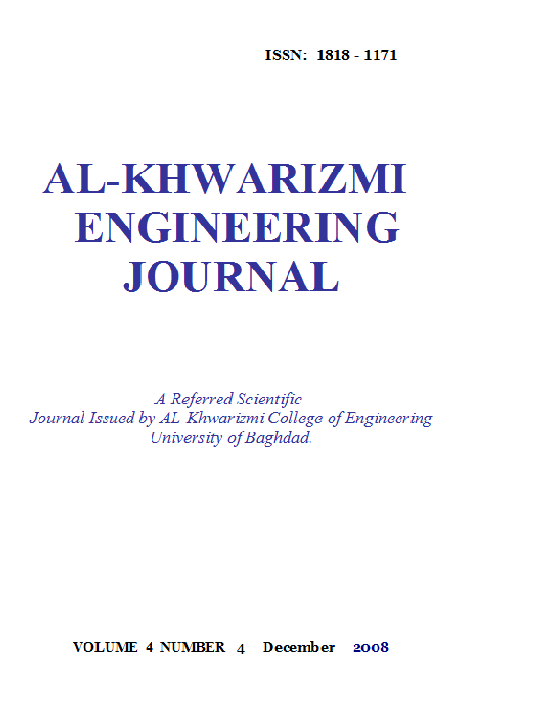The Effect of Additives on The Performance of Hydrostatic Thrust Bearings
Abstract
The paper is concerned with, the behavior of the hydrostatic thrust bearings lubricated with liquid-solid lubricants using Einstein viscosity formula, and taking into account the centrifugal force resulting from high speed. Also studied is the effect of the bearing dimensions on the pressure, flow rate, load capacity, shear stress, power consumption and stiffness.
The theoretical results show an increase in load capacity by (8.3%) in the presence of solid graphite particles with concentration of (16%) by weight as compared with pure oil, with increasing shear stress. .
In general the performance of hydrostatic thrust bearings improve for load carrying capacity, volume flow rate, pumping power subjected to centrifugal parameter (S), recess position (r1), film thickness ratio (b), particle concentration (l).
Downloads
References
[2] R. S. Brand, 1956, Journal of Applied Mechanic, vol.77 pp. 363.
[3] Dowson, D., 1961, “Inertia effects in hydrostatic thrust bearings,” ASME, Journal of Basic Engineering, vol. 83 pp. 227.
[4] C. Chung, Moon and D. W. Darcing. 1976, “ The contribution of fluid film inertia to the thermohydrodynamic lubrication of sector pad thrust bearings,” ASME Journal of Lubrication Technology, vol.98, pp.
[5] O. Pinkus and J. W. Land, 1981” Centrifugal effects in thrust bearings and seals under laminar conditions,” ASME Journal of Lubrication Technology, vol. 103, pp. 126-136.
[6] R. S. Gupta and V. K. Kapur, 1982, Wear, vol.77 pp. 203.
[7] S. Safar. 1983, “ Centrifugal effects in misaligned hydrostatic thrust bearings,” ASME Journal of Lubrication Technology, vol.105 pp. 621.
[8] Coombs, J. A. Dowson, D., 1965 “An experimental investigation of the effect of lubrication inertia in hydrostatic thrust bearing,” 3rd Lub. And wear conv. Proc. IME, London, U, K. vol. 179 part 3J, P. 96.
[9] V. K. Kapur and K. Verma, (1975) “ Energy integral approach for hydrostatic thrust bearing,” ASME Journal of lubrication technology vol.97 n.4 pp.697.
[10] Yousif, A. E., and Nacy, S. M., 1981 “ Hydrodynamic Behavior of two-phase (liquid-solid) lubricants,” Wear, Vol. 66, No. 2, pp.223-240.
[11] Yousif, A. E., and Hassan, K. J., 1985 “The Lubrication of Journal Bearings with two-phase (liquid-solid) lubricants,” Proc. Of the JSME Int’ l Trib. Conf. Tokyo, pp. 1121-1126.
[12] Khalil, M. F. and Ismail, A. S., “Performance characteristics of externally pressurized bearings under turbulent flow conditions,” Sited from ref [6].
[13] Osterele, J. F, and Huges, W. F., 1961” Inertia induced cavitation in hydrostatic in hydrostatic thrust bearings,” WEAR, vol. 4 pp. 228.
[14] Khalil, M. F Ismail, A.S. (1989) “Centrifugal effects in externally pressurized bearings under turbulent flow conditions,” Tribology International vol.22 n.4 pp. 265-272.
Downloads
Published
Issue
Section
License
Copyright: Open Access authors retain the copyrights of their papers, and all open access articles are distributed under the terms of the Creative Commons Attribution License, which permits unrestricted use, distribution, and reproduction in any medium, provided that the original work is properly cited. The use of general descriptive names, trade names, trademarks, and so forth in this publication, even if not specifically identified, does not imply that these names are not protected by the relevant laws and regulations. While the advice and information in this journal are believed to be true and accurate on the date of its going to press, neither the authors, the editors, nor the publisher can accept any legal responsibility for any errors or omissions that may be made. The publisher makes no warranty, express or implied, with respect to the material contained herein.












